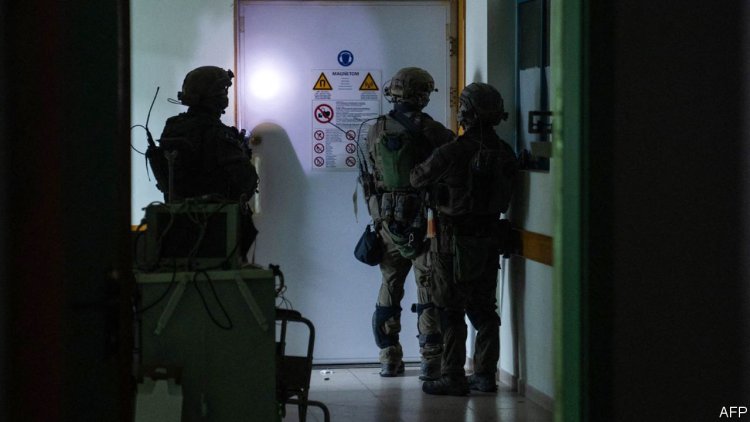Was Israel’s attack on al-Shifa hospital justified?
image: AFPTHE LAWS of war give special protection to hospitals. They lose that protection if they are used for “harmful” acts. Israel has long claimed that al-Shifa hospital, the largest in the Gaza Strip, serves as a key command centre for Hamas, the group which killed or took hostage around 1,400 people in Israel on October 7th. In the early hours of November 15th, after a tense six-day stand-off, members of Shaldag, an elite Israeli air-force commando unit, entered one wing of the hospital.So far there is little evidence of its being a major military facility. Only the coming days will determine whether Israel has in fact rooted out a Hamas headquarters. Whether good evidence turns up matters to both sides. For Israel, the hospital is a prime example of how Hamas hides behind innocent civilians inside targets that are calculated to provoke outrage if they are attacked. For the Palestinians, targeting a hospital is emblematic of how cheaply Israel values Palestinian suffering. If Isr


THE LAWS of war give special protection to hospitals. They lose that protection if they are used for “harmful” acts. Israel has long claimed that al-Shifa hospital, the largest in the Gaza Strip, serves as a key command centre for Hamas, the group which killed or took hostage around 1,400 people in Israel on October 7th. In the early hours of November 15th, after a tense six-day stand-off, members of Shaldag, an elite Israeli air-force commando unit, entered one wing of the hospital.
So far there is little evidence of its being a major military facility. Only the coming days will determine whether Israel has in fact rooted out a Hamas headquarters. Whether good evidence turns up matters to both sides. For Israel, the hospital is a prime example of how Hamas hides behind innocent civilians inside targets that are calculated to provoke outrage if they are attacked. For the Palestinians, targeting a hospital is emblematic of how cheaply Israel values Palestinian suffering. If Israel fails to justify its charges against al-Shifa, its operation in Gaza will be undermined.
Start with the public claims. On October 27th the Israel Defence Forces (IDF) said that al-Shifa, which is in the centre of Gaza city, was the “focus” of Hamas’s activity in the Gaza Strip. It said the site had “several underground complexes” used by leaders, including a “control centre” for Hamas’s internal-security unit and a “headquarters” to direct rocket fire, command forces and store weapons. A slick “intelligence-based” video published by the IDF the same day showed a 3D model of the hospital with a Bond-villain lair beneath, including labyrinthine corridors, large meeting rooms and rows of laptops.
Israeli officials have said that Hamas had begun creating the facility by 2007, enlarging basements originally dug by Israel when it expanded the hospital in the 1980s. They have also said it had several floors and space for several hundred people. Amnesty International, a human-rights organisation, has said that Hamas had used parts of al-Shifa “to detain, interrogate, torture and otherwise ill-treat suspects” in 2014. Hamas’s leadership is thought to have holed up below the hospital during wars in 2009 and 2014. Israeli officials say it has been used to treat the 240 hostages captured on October 7th, some of whom were wounded or had pre-existing conditions.
America has endorsed many of these claims. On November 14th John Kirby, a spokesman for the White House, said that Hamas and Palestinian Islamic Jihad, a smaller group, operated a “command-and-control node” from al-Shifa. On November 16th, after the IDF had entered the site, Mr Kirby said America was “still convinced of the soundness of [its] intelligence”.
Hamas denies the allegations, and medical personnel at al-Shifa say they have seen no evidence of them. The proof Israel has produced so far has been underwhelming. The IDF says it has found “intelligence materials, military technologies and equipment, command-and-control centres, and communications equipment” at al-Shifa. It has published photographs showing guns, ammunition and Iranian-made anti-tank rockets it says were found in the MRI department, as well as the entrance to an unexplored tunnel shaft. Separately, the IDF has found the bodies of two hostages near the hospital. It has also taken some unidentified bodies back to Israel.
It is too early to reach a definitive judgment on whether Israel’s most dramatic claims will eventually be backed by evidence. One reason is that it has so far combed through only a small part of the hospital compound. The IDF is negotiating with medical staff on evacuating the site, which is likely to take several days. Troops are also moving slowly for fear of booby traps. They are under strict orders not to enter tunnels and have used robots and sniffer-dogs to explore them. Israeli officials insist that “there is much more terror infrastructure in the area of the complex that is well hidden.” What’s more, they say, Hamas has had weeks to cover its tracks since it became clear that Israel’s ground offensive would be far larger than in the past.
Even if Israel does find evidence, it may not meet the expectations of the watching world. In legal terms, the discovery of a weapons cache could be enough to cause a hospital to lose its protection. However, the Geneva conventions specify that the presence of small arms and ammunition taken from wounded combatants is not enough to qualify. And whatever the letter of the law, finding a clutch of Kalashnikovs and grenades would not be seen by many to justify taking over Gaza’s largest hospital. As a further complication, a command-and-control “node” or “headquarters” is unlikely to resemble the operations room of a conventional army or the IDF video. One tell-tale sign might be communications infrastructure: Hamas is thought to have planned the October 7th attack using hardwired telephone lines, rather than mobile-phone and internet networks monitored by Israel.
Israel itself is largely responsible for the high expectations. Many Israeli defence personnel are privately critical of the IDF Spokesperson’s Unit for building up an unrealistic picture of what might be found underneath al-Shifa and exaggerating its centrality to Hamas. Even Israeli intelligence officials do not believe that the group currently has its main headquarters—to the extent that such a thing exists—below the hospital. These, they say, have probably moved to Khan Younis, a city in southern Gaza that lies beyond Israel’s current zone of operations. On November 15th the IDF dropped leaflets on the city warning residents of certain neighbourhoods to leave.
In practice, Hamas’s command-and-control structure is fluid. The group’s military wing, the Qassam Brigades, does not have a single official headquarters or permanent bases. That has presented the IDF with two challenges. One is the intelligence problem of finding commanders. In recent years, the IDF’s military-intelligence branch has attempted to refresh its pre-war “target bank” by using artificial intelligence to analyse data collected from satellites and aerial surveillance. That process is opaque.
The other challenge is legal. Under the laws of war, an otherwise-civilian object can become a military one by its “purpose”—if Hamas intends to return to a site in the future, it may be targeted. But the rules for hospitals are tighter. The International Committee of the Red Cross, a humanitarian organisation, says that an army must “interrupt” its attack “if the facility no longer meets the criteria leading to the loss of protected status”—for instance, if combatants have fled. The IDF, which appears to take an expansive view of the rules for hospitals as it does with all targeting, says that after several wars in which Hamas leaders have hunkered down under al-Shifa, Israel intends to clear out the hospital once and for all. ■
What's Your Reaction?

















